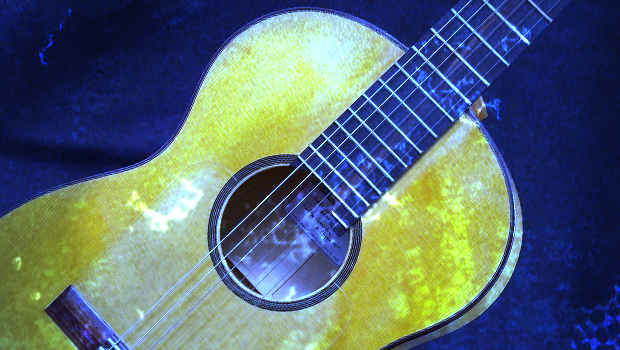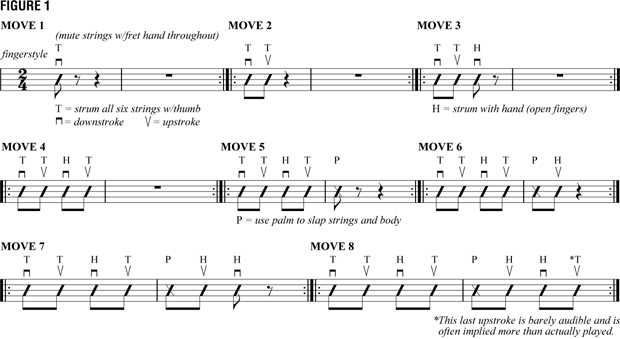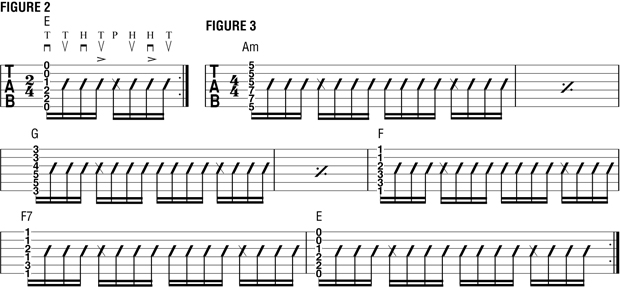One of flamenco guitar's great strum patterns demystified

This lesson is taken from the October 2010 edition of Guitar 101.
One thing I like to teach my students at GIT is the lively rumba flamenco rhythm, which has gained a lot of popularity in mainstream music as of late. What follows is not necessarily the original and only way that flamenco players play this rhythm, but that’s okay. If you analyzed the rumbas of three great flamenco guitarists, you would likely find that they each strummed them a little differently.
The classic rumba is a lot of fun, and it involves the eight basic open-hand strumming-hand moves shown in FIGURE 1. Once you understand this sequence of various strums and strikes, you’ll have a much better understanding of what flamenco players are doing when you see them in action.

Muting all six strings with your fret hand, learn Moves 1 through 8 in order, noticing that each move builds upon and includes within it the previous one. (For example, Move 5 includes Moves 1 through 4.) In other words, once you can comfortably loop Move 8, you’ve got the rumba pattern down.
- Move 1: Down-strum with your thumb (T).
- Move 2: Up-strum with the thumb (T).
- Move 3: Down-strum with your hand (H), opening your fingers all at once so the nails of one or more fingers strike the strings. At the end of this move, the thumb should reside right below the strings, in preparation for Move 4.
- Move 4: Up-strum with the thumb (T).
- Move 5: Slap all six strings and the body of your guitar with your hand’s palm (P) and fingertips.
- Move 6: Close your hand (H), thus up-strumming the strings with your fingertips. (This is essentially the opposite of Move 3.)
- Move 7: Down-strum with your hand (H), as in Move 3.
- Move 8: Up-strum with the thumb (T), barely grazing the strings.
Your first goal should be to get comfortable looping Move 5. Then, add the final three strums, knowing that the last pulse in Move 8 is often hardly audible, implied more so than actually played. When you can loop Move 8, try the pattern on an open E chord, as in FIGURE 2. (Notice that we’ve shifted to writing the pattern in 16th notes, and that, in classic flamenco style, we’ve added accents on the fourth and seventh pulses.)

We’ll close with FIGURE 3, the typical cadencia andaluza (Andalusian cadence), a pleasing progression you’ve surely heard before that comes from the Andalusian region of Spain. It is featured in many traditional flamenco songs. I’ve switched to writing the pattern in 4/4 time (i.e., twice per measure) and have simplified its presentation (because you already know the moves).
This example uses mostly barre chords, but if you prefer, you could play Am and G as open chords. Interestingly, in flamenco music, the E in this progression is considered the I chord (though in pop music, people would think of this as being an A minor progression, with E being the V chord). Stay loose, have fun with the pattern, and be sure to watch the accompanying video to really see how it flows.
Marcelo Berestovoy has toured and/or recorded with everyone from León Gieco and Paulina Rubio to Selena and Ricky Martin. He teaches acoustic and electric guitar approaches at GIT, the Guitar Program at Musicians Institute.
Get The Pick Newsletter
All the latest guitar news, interviews, lessons, reviews, deals and more, direct to your inbox!
“There are so many sounds to be discovered when you get away from using a pick”: Jared James Nichols shows you how to add “snap, crackle and pop” to your playing with banjo rolls and string snaps
Don't let chord inversions bamboozle you. It's simply the case of shuffling the notes around







![Joe Bonamassa [left] wears a deep blue suit and polka-dotted shirt and plays his green refin Strat; the late Irish blues legend Rory Gallagher [right] screams and inflicts some punishment on his heavily worn number one Stratocaster.](https://cdn.mos.cms.futurecdn.net/cw28h7UBcTVfTLs7p7eiLe.jpg)


